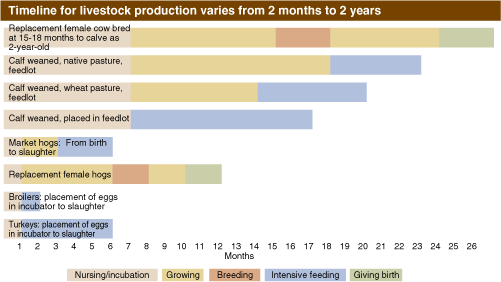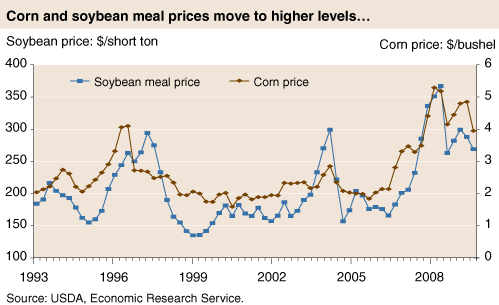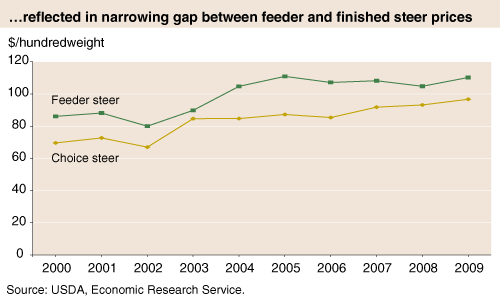Grain Prices Impact Entire Livestock Production Cycle
- by Richard Stillman, Mildred Haley and Kenneth Mathews
- 3/1/2009
Highlights
- Between 2006 and 2008, feed costs nearly doubled and are expected to result in lower meat and dairy production in 2009.
- Feed prices have declined since mid-2008 and are expected to be lower in 2009, but the biological timeline of livestock production means meat producers are limited in what they can do in the short run to change production.
- Changes in U.S. livestock-industry structure and the use of alternative feeds, such as byproducts from ethanol production, will help reduce the impact of higher input costs on livestock producers.
Manufacturers make decisions on the amount and timing of production based on input costs and the expected product price. Manufacturers may react to a significant increase in the price of a variable input, such as energy, by reducing production. As energy prices decline, manufacturers may respond in the short run by boosting output.
Biology, however, prevents livestock producers from instantly responding to price changes. The timeline for meat production—from farm to retail—ranges from 2 months for poultry meat to 2 years for beef. From the time a female is bred, it takes about 9 to 10 months to expand milk production, 30 months to produce a steak, 10 months for a pork roast, and 10 weeks for a chicken breast from when incentives to do so appear.
Livestock production’s varying timeframes make it difficult to change the direction of output quickly. Producers make decisions to expand or contract production before feed and product prices are known. Biological lags mean that animal products consumed today are based on production decisions made up to 2 years ago.
Record-high grain, oilseed, and energy prices between 2006 and 2008 increased the costs of producing and marketing meat and dairy products. Expecting feed and energy costs to remain high, livestock producers began to cut back on animal and dairy production. But just as producers were making their livestock-production decisions for 2009, feed prices began to decline. The dollar strengthened, which lowered exports, and worldwide economic growth began to slow.
As a result of decisions made before the end of 2008, livestock production will likely grow more slowly in 2009 and could begin to decline. Because of this, consumers can expect to pay higher prices for meat and dairy products through 2009, even as the costs of feeding and raising livestock decline.
Higher Feed, Energy Prices Shape Production Decisions
Prices paid for feed doubled from 2006 to 2008, mainly due to higher corn and soymeal prices. Corn accounts for 91 percent of feed grains used for feed, and soymeal is the principal oilseed crop product used as feed. By mid-2008, corn prices were about 140 percent above those of a year earlier. Similarly, soymeal prices reached a record $367 per ton in 2008.
Increased energy prices also affected the livestock sector in a number of ways, raising the costs of slaughtering, processing, and retailing. Beyond the slaughter plant, meat and dairy products require what is known as a “cold chain” of energy-intensive refrigeration. Margins, the difference between live animal prices and retail meat prices, are a reflection of the cost of processing the meat. To cover higher energy costs, margins must also rise.
Feed and energy costs are large components of livestock production expenses. The length of time necessary to produce meat animals governed the short-term reaction of the livestock industry to these higher input costs. Initially, livestock producers continued to feed the animals in the production queue, while eliminating their least productive animals and cutting back in less profitable areas of their operations.
Two Cattle Industries Affected Differently by Higher Costs
Two separate industries comprise U.S. beef production. The cow-calf industry, which produces calves that go into feedlots, is pasture based and is less directly affected on the cost side by rising grain prices. Higher grain prices do affect cow-calf producers indirectly, however, through lower prices offered for their output—feeder cattle, which are placed in a feedlot to be fattened prior to slaughter.
The demand for feeder cattle is a “derived demand”—demand for a good or service that is an input into the production of another good or service. The demand for the input is derived from the demand for the final output. As feed prices increase or finished-cattle prices decline, cattle feeders will pay less for the feeder cattle purchased from cow-calf producers. The differences between feeder- and finished-cattle prices began to increase in the second quarter of 2004, an indication of higher demand for feeder-cattle. The difference narrowed substantially in the fourth quarter of 2006, with the sharp runup in corn prices, and remained much lower than from the third quarter of 2004 to the same period in 2006. The change in 2006 indicated demand for feeder cattle had declined.
The cattle-feeding industry is more directly affected by feed costs than are cow-calf operations. When feed costs are high, cattle feeders can adjust by buying heavier feeder cattle that had remained on pastures, eating forage, for a longer period of time. When feed costs are lower, cattle producers may put feeder animals in the feedlot at a lower weight in order to gain more weight from grain-based feed rations. Feeder animals typically enter the feedlot weighing 650 to 800 pounds and are slaughtered at 1,250 to 1,350 pounds. During their time in a feedlot, cattle consume about 3,000-3,200 pounds of corn. If feed costs rise, cattle feeders can wait until their animals are 100 to 300 pounds heavier (from the typical 650 to 800 pounds) before placing them in feedlots. This practice reduces the amount of grain needed to “finish” the cattle. But there are limits to this practice because it can lower the quality grade (e.g., USDA Choice) of the beef animal.
Some Producers Have More Feed Options Than Others
Livestock producers can adjust feed costs by altering the types and amounts of feed in rations and by changing feeding practices. The resulting “least-cost” ration varies the amount of specific feeds, depending on costs. Typical feed rations are made up of energy (carbohydrates and fat) and protein. If feed costs increase, cattle can eat grass for growth and milk production. Cattle and dairy producers can reduce the amount of feed grains and protein meals fed to cattle by giving them more forage.
Livestock producers can also use alternative feeds, like distillers’ dry grains (DDGs), one of several byproducts of grain-based ethanol and sweetener production that can be fed to livestock. With expanded ethanol production, DDGs are likely to become a more important component of feed, particularly for cattle, and will offset some of the demand for traditional feeds like corn.
Cattle feeders can use DDGs for up to about 60 percent of their feed rations, mixing DDGs with straw or corn stubble. Cattle feeders also can use byproducts coming directly from ethanol production plants in a wet form, avoiding the high cost of drying DDGs. One problem with wet grain byproducts is that the high moisture content makes the cost of shipping them more than about 100 miles prohibitive. Even so, DDGs and the wet byproducts will become a more important component of feed and will offset some of the demand for traditional feeds. Recently, there has been an increase in cattle fed in areas in the Midwest near ethanol plants.
The story is different, however, for hog and poultry producers. They have fewer alternative feed sources because hogs and poultry are monogastric (stomachs with only one compartment). These animals also need a balanced diet of energy and protein, but cannot easily digest cellulose from ethanol byproducts or forages. Pork and poultry producers cannot use pasture grazing to reduce feed costs. The feeds used for pigs and chickens/turkeys are energy (feed grains like corn) and protein meals (soybean meal). The pork and poultry industry can use ethanol byproducts for energy if the cost is low enough, but this practice can affect the rate of weight gain and the meat quality at high rates of inclusion in the diet. DDGs can be used as feed for pork and poultry production, but there are limits to the amounts that may be fed to preserve meat quality, and the DDGs are best utilized in a dry form, which raises costs.
Dairy producers have some of the advantages of feed alternatives that beef-cattle producers have, along with some of the disadvantages pork and poultry producers share. Dairy producers can reduce costs by replacing some feed grains with forage. However, there is a tradeoff—as dairy producers increase forage use, average milk yields will decline. Dairy producers can also use DDGs, though they cannot rely on the substitution as much as producers of beef cattle.
Changing Industry Structure Will Alter Supply Response
The pork and poultry industries have one significant advantage in feed costs over cattle and dairy producers. Vertical integration and contracting may limit the contraction in the pork and poultry industries in response to higher feed costs because the whole marketing chain from farm to retail is viewed as a single profit center, which can better absorb price shocks in one part of the vertical supply chain.
The structure of U.S. animal production, particularly pork and poultry, has changed dramatically in the past 25 to 50 years. The industry has shifted from a large number of small, independent, diversified producers to fewer but larger, more specialized, and more capital-intensive supply-chain-coordinated operations. This structural change in animal production will likely affect the sector’s response to sustained high feed costs.
Under the structure in place prior to the 1980s, contraction of output—and thus higher product prices—came about almost entirely through the exit of higher cost producers. Under the new larger structure, industry-wide negative returns will be reversed less often by producer exits than through sales of production facilities to new owners at reduced prices. The new owners, having purchased assets at cents-on-the-dollar, will operate the facilities at lower break-even prices because they have lower capital costs to cover. Consequently, output adjustments will be smaller than in the past. The new operators are also likely to be more efficient and so will be better able to survive a period of high feed costs. However, new entrants will be discouraged until product prices rise sufficiently to allow all allocated costs to be covered.
There is considerable quantitative evidence to suggest that animal-product output does not have to fall significantly to bring about an increase in output price. Demand for meats is inelastic, meaning that for any given change in the supply of meats, the price will change at a greater rate than the corresponding quantity change. For example, if the supply of beef decreases by 1 percent, the price of beef will increase by 1.5 percent. So, a relatively small decline in supplies of beef, pork, or poultry could raise prices sufficiently to cover higher feed costs. Alternatively, prices could rise even with stable supplies if demand continues to steadily increase.
In 2009, meat production is expected to decline because producers have already made decisions based on their 2007-08 expectations of higher grain and energy prices. Per capita meat supplies are likely to fall, and consumers can expect to pay more for meats and dairy in 2009. The magnitude of the production decline is unknown, as some livestock producers can adjust more quickly than others to changing costs.
An even larger unknown is the length and depth of the economic downturn that began in late 2008 and its potential effect on demand for meats. What is certain is that due to biologically determined timelines in livestock production, fluctuating grain and oilseed costs and variable meat prices make it more difficult for producers to gauge which way the market price will be heading when their product is ready to be sold.
This article is drawn from:
- Mathews, K. & Haley, M. (2016). Livestock, Dairy, and Poultry Outlook. U.S. Department of Agriculture, Economic Research Service. LDPM-260.
You may also like:
- Feed Grains Database. (n.d.). U.S. Department of Agriculture, Economic Research Service.
- Bioenergy. (n.d.). U.S. Department of Agriculture, Economic Research Service.
- Animal Policy & Regulatory Issues. (n.d.). U.S. Department of Agriculture, Economic Research Service.
- Capehart, T., Allen, E. & Bond, J.K. (2012). Feed Outlook: November 2012. U.S. Department of Agriculture, Economic Research Service. FDS-12K.




